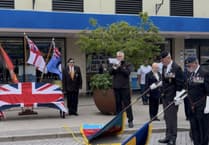AN 84-YEAR-OLD glider pilot who suffered serious injuries in a glider crash on a training exercise could have landed the aircraft safely, investigators have said.
The accident at Usk Airfield on Sunday, June 13, 2021, left the octogenarian and his 60-year-old instructor with significant neck and back injuries.
A report by the Air Accidents Investigation Branch said “there was sufficient distance available for the glider to have been landed straight ahead” when the pensioner pilot was being assessed during a simulated failed winch launch.
But the glider was flown away from the airfield beside the busy A449 in a bid to turn and land on a dog-leg runway, and crashed after stalling and colliding with trees, by which time the instructor had taken over the controls.
The report said the pilot, who first flew a glider some 60 years ago, wanted to revalidate his winch lift off documentation, and the duo were lifted into the air in a Grob G103C Twin III Acro.
“The instructor reported that at a height of about 150 feet he jettisoned the winch cable to simulate a launch failure,” said the investigators. “The pilot stated that he reacted by rapidly lowering the nose, with the aircraft quickly achieving safe flying speed.”
The elderly pilot “did not believe he had sufficient distance to land safely straight ahead, but that he did have sufficient distance to land the glider in an area of the airfield extending to the left of the end of Runway 28”, the report added. “He turned the glider to the right, flying away from the airfield to position it for a landing across the airfield at the end of Runway 28.”
But the instructor said he was “surprised” by the turn, as he was “expecting the pilot to land straight ahead… due to the aircraft’s low height”.
Witnesses on the ground also believed there was sufficient distance for the glider to land straight ahead on the remaining runway, said investigators.
But it flew away from the airfield for “a few seconds” before turning left back towards it by which time the aircraft was so “low that it was in danger of colliding with trees at the edge of the airfield”.
The instructor said he had taken over the controls by this point, and tried to turn further left between a gap in the trees. But the nose had dropped and the glider, now too low and too slow, hit a tree before striking the ground, seriously injuring both occupants.
The impact caused the glider to pivot sharply around the tree before coming to rest, with the left wing separated from the fuselage except for the aileron and airbrake control rods.
The pilot, who had been an assistant gliding instructor for 13 years, had starting flying in his early 20s, but hadn’t flown for 37 years before restarting at Usk Airfield in 2010.
The report added that while the pilot was “confident” he had taken the right action and positioned the glider to land in the ‘dogleg’ area, witnesses on the ground said it had not adopted “a sufficiently nose-down recovery attitude”.
“They had also expected the glider to land in the area remaining immediately ahead which, to them, seemed more than adequate.”
Measurements later showed “there would have been sufficient distance... straight ahead, as the instructor had anticipated”, but the latter said he hadn’t intervened earlier “due to the experience of the pilot”.
“Whilst there are differing recollections of who was flying the glider when it turned back towards the airfield, it is clear that the glider had by then descended too low to make it to the airfield safely,” stated investigators.
The report noted that there had been no full briefing before the exercise, providing a more thorough assessment of the pilot’s knowledge of the exercise, which was a more hazardous operation than normal.
It added: “Following the accident, the gliding club worked with the British Gliding Asoociation to review the safety of its operation and they put in place a number of safety actions.
“These actions were intended to address the areas in need of immediate improvement with a more long-term engagement aimed at achieving a continued improvement in safety.”





Comments
This article has no comments yet. Be the first to leave a comment.